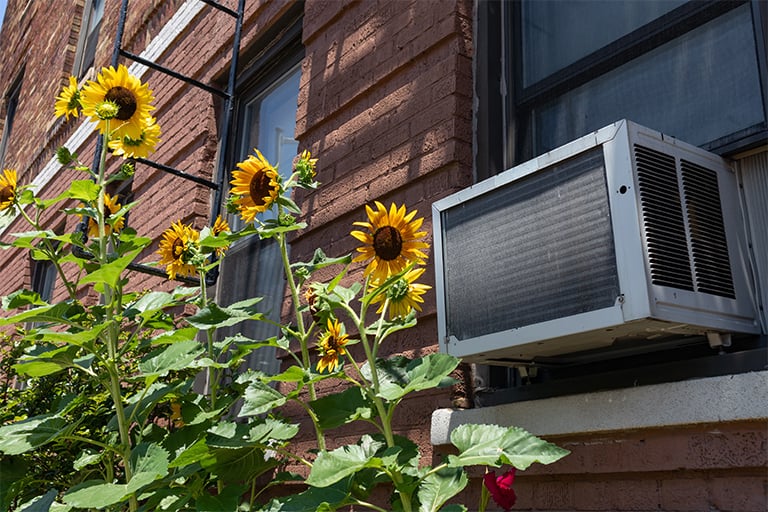
What you’ll pay in Columbus, OH, for furnace repairs depends on many factors. Here’s a breakdown of what can go wrong and the cost to fix those issues.
If your window AC unit is on the fritz, it could mean a simple fix or a call to a technician


Familiarizing yourself with the parts of a window AC will better help you troubleshoot problems.
A pro always needs to handle any issues related to refrigerant or electrical work.
Ice on your unit is one of the most common window AC problems that stems from obstructed airflow, the wrong-sized AC, dirty coils, or low refrigerant levels.
Regular maintenance, like replacing filters, inspecting the unit, and cleaning off the unit and surrounding areas, can help you avoid many common window AC issues.
Air conditioning units can be a lifesaver during the scorching summer months, but they are not without their problems. Find out how to fix some of the most common window air conditioning problems—or learn what to say when you call a pro for help—so that you and your family can stay cool all summer long.
To ensure safety, disconnect your air conditioner from power before checking for the source of a problem. Do this by unplugging the cord at the wall or switching the breaker that operates it. Make sure to follow the manufacturer's guidance when troubleshooting.
While you can attempt to look into some small problems by cleaning your unit and clearing obstructions, you should always contact a repair technician to perform any electrical work.

Familiarizing yourself with the individual components of your air conditioner is the unofficial first step. Finding out which part isn't working will allow you to identify and repair any problems quickly or give your pro the knowledge to help you more easily.
Face panel: Removing the grille cover, also known as the face panel, that often sits in front of your air conditioner is always a priority. Depending on the unit you have, it may use only screws or clips, or tabs to keep it in place.
Filter: The filter protects the air conditioner's internal components from dirt and debris. It also cleans the air before recirculating it back into the room. The filter might be inside or behind the face panel.
Evaporator: The evaporator converts hot air into cool air. The copper tubing houses refrigerant, which helps to complete this process. The coil contains the refrigerant that will cool your room, and it's surrounded by thin aluminum fins to increase efficiency.
Condenser: The condenser is the part of the window air conditioner on the back of the unit that moves the hot air out of your home.
Refrigerant: A liquid circulates through the air conditioning unit's evaporator and condenser coils to produce cool air. You should not attempt to handle this substance.
Compressor: The compressor turns the liquid-state refrigerant into a hot gas. The evaporator cools it down at the same time to return it to its original state.
Thermostat: The thermostat is a copper tube sensor. It regulates the air conditioner's on/off cycle and usually clips onto the front of the evaporator.
Drain pan: The angled pan at the bottom of the unit collects moisture produced from the evaporator and prevents moisture from leaking into your room. The pan directs it towards its drain port on the back of the frame.
Condensation drain: The condensation drainage system connects the overflow pan to the drainpipe.
Sensor wire: The sensor wire on a window air unit is located in front of the evaporator on the AC. This wire turns the unit on and off based on the temperature in the room’s air.
If your window AC doesn’t turn on, check if it's receiving power. Unplug it, then plug a different appliance into the same outlet. If it still doesn't turn on, check your circuit breaker.
If the AC has power, the problem could be related to a number of components within the unit, including the wiring, thermostat, compressor, selector switch, or control board. A local window AC repair technician should repair these items
If your air conditioner has low refrigerant, either the pressure in the system was not charged enough or leaks are present. Either fix should be done by a professional.
The most common leaks are in the tubing on top of the unit (evaporator), at connections to coils and fittings (condenser), or from its drain pan. The types of leaks that will be present depend largely upon where they started. For instance, if there's an evaporator leak, frost may form inside the piping, leading to more noticeable dripping near the outside unit.
A local window AC repair technician will diagnose any problems with the unit and, if there is a leak, fix it before releasing the unit. Then they will charge the system with refrigerant before testing it.

You may notice water leaking from the front panel, which could mean the drain pan is sloped away from the drain port. This often happens when the AC unit sits unlevel in the window. Unplug the AC and level the unit to align the drain pan and ensure the moisture drains away rather than leaking out of the front of the unit.
If you’ve already performed the troubleshooting in step one, this is another one that you won’t be able to tackle yourself. Your AC unit could be plagued by one of a few things, but you’ll probably need to call in a pro to narrow it down.
A professional AC repair person will service and check for electrical connections and contacts for corrosion. Worn-out compressor and fan controls will often produce the same effect when units turn on and off rapidly.
Room air conditioners have sensors that measure how cold the room is and control the flow of coolant. If these sensors break, your air conditioner might constantly cycle or won’t change to the proper temperature.
The sensor wire should bend so that it's near the coil but not touching it. You can easily do this yourself, so it senses the temperature correctly but be sure the unit is turned off and that you’re using caution.
You can also check the air damper. If it's open, it will bring in outside air, which is bad for efficiency. Also, check the back cover, which many people forget to remove after the winter season. Finally, check the condensing coils, which are located on the warm end of the air conditioner. Remove the air conditioner's cover to access the coils, and clean them with a soft brush.
Condensation drainage obstruction is the number one cause of a window air conditioner leaking outside the house. Dirt and debris buildup could interfere with the airflow and cause condensation buildup.
To fix these problems, check the condensation drain to make sure it is working correctly with no obstructions and it's mounted on a surface that won't slope away from the drain.
Aside from a rare ice storm in July, ice on your AC unit usually indicates a problem. There could be several reasons for a frosty air conditioner:
Too little refrigerant
Obstructed airflow from a dirty filter or coil
The AC unit is too large for the room it is installed in
The compressor needs replaced
The outdoor air temperature is too low (below 62°F)
Beyond cleaning the filters and coils to encourage airflow, you’ll want to leave diagnosing and repairing the issue to the pros.
There’s nothing quite as frustrating as dealing with a blown fuse every time the AC kicks on. If this is an all too familiar occurrence in your household, your AC unit might be overloading the circuit and need a dedicated circuit to run properly.
Try allocating other devices and appliances to outlets on a separate circuit first. If that doesn’t work, hire a local electrician to set the AC unit up on a dedicated circuit. This will cost about $100.
A gentle humming noise is normal and should hardly bother your day-to-day life. But banging, buzzing, and clanking? Those noises suggest it’s time to take a closer look.
Weird AC unit noises usually mean something is wrong with one of many fan parts, including the fan belt, fan blades, or fan motor. You may need to simply lubricate the fan motor or straighten out a bent fan blade. More serious damage might require a pro to replace the fan belt.
The AC unit can make loud noises if it’s not properly installed in the window, which can cause it to vibrate against the window sill or frame. Also, try removing the front panel and peeking inside for debris or unwelcome guests who may have entered the unit from outside.
Maintaining your air conditioner is the best way to avoid having to fix it in the first place. Dirty filters and coils cause AC units to work less efficiently. The filter is the leading cause of it failing prematurely.
To keep your window AC running smoothly, maintain it properly. Maintenance can protect you from being stuck with a busted unit during the hot summer months.
To prepare for air conditioning and maintain it during warmer months, take the following steps:
Change the filter every three months during use
Inspect windows for possible repairs at a cost
Clean windows, wipe down window tracks, and scrub window screens before installation Inspect and clean coils
Inspect and clean coils
Vacuum out the entire AC unit to remove dust or debris that may have accumulated during the off-season.
Cover and store the unit away from dust and debris during cold months
From average costs to expert advice, get all the answers you need to get your job done.

What you’ll pay in Columbus, OH, for furnace repairs depends on many factors. Here’s a breakdown of what can go wrong and the cost to fix those issues.

When your heat goes out, it can cause a bit of a panic. But knowledge is power, so let's go over radiator repair costs before that happens.

Find out the average humidifier repair cost, what impacts pricing, and how to save. Get expert tips to budget for your humidifier repair.

An HVAC zoning system makes your home more comfortable. Learn about installing a zone system, including HVAC zoning system costs and considerations.

Tackling unwanted odors from indoor plants can be tricky. Learn how to use a carbon filter in your duct fan to improve air quality.
Furnace trouble can be frustrating, so learning the telltale signs of a failing furnace is important. Recognize the following red flags for a malfunctioning furnace.